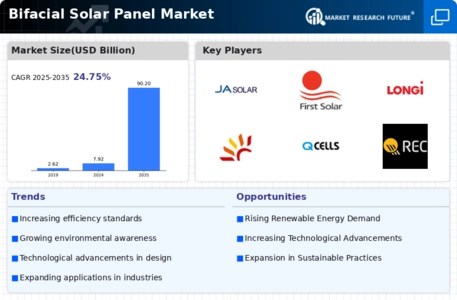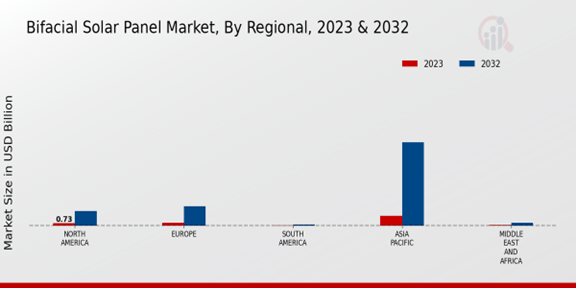Increasing Energy Costs
The rising costs of traditional energy sources propel the Global Bifacial Solar Panel Market Industry forward, as consumers and businesses seek more cost-effective alternatives. Fluctuating fossil fuel prices and the growing awareness of energy security issues lead to a shift towards renewable energy solutions. Bifacial solar panels, with their enhanced efficiency, offer a viable solution to mitigate energy expenses. As energy prices continue to rise, the attractiveness of solar energy becomes more pronounced, prompting increased investments in solar technologies. This trend is expected to sustain the market's growth trajectory, aligning with the broader global transition towards sustainable energy.
Market Growth Projections
The Global Bifacial Solar Panel Market Industry is poised for remarkable growth, with projections indicating a market value of 7.92 USD Billion in 2024 and an anticipated surge to 90.2 USD Billion by 2035. This growth trajectory reflects a compound annual growth rate of 24.75% from 2025 to 2035, underscoring the increasing adoption of bifacial solar technology across various sectors. The market dynamics are influenced by factors such as technological advancements, government incentives, and rising energy costs, all contributing to the expanding footprint of bifacial solar panels in the global energy landscape.
Growing Environmental Awareness
The Global Bifacial Solar Panel Market Industry benefits from a heightened awareness of environmental issues among consumers and businesses alike. As climate change and environmental degradation become pressing concerns, there is a growing demand for clean energy solutions. Bifacial solar panels, which offer higher energy yields and lower carbon footprints, align with the values of environmentally conscious consumers. This shift in consumer behavior is likely to drive market expansion, as more individuals and organizations prioritize sustainability in their energy choices. The increasing focus on corporate social responsibility further amplifies this trend, positioning the bifacial solar panel market for substantial growth.
Rising Demand for Renewable Energy
The Global Bifacial Solar Panel Market Industry experiences a surge in demand driven by the increasing global emphasis on renewable energy sources. Governments worldwide are implementing policies and incentives to promote solar energy adoption, aiming to reduce carbon emissions and combat climate change. For instance, countries like Germany and China have set ambitious targets for renewable energy integration, which fuels the demand for efficient solar technologies. This trend is expected to contribute to the market's growth, with projections indicating a market value of 7.92 USD Billion in 2024, reflecting a growing recognition of the need for sustainable energy solutions.
Government Incentives and Subsidies
Government incentives and subsidies significantly influence the Global Bifacial Solar Panel Market Industry, encouraging both residential and commercial adoption of solar technologies. Various nations offer financial support, tax credits, and rebates to promote the installation of solar panels, thereby reducing the initial investment burden for consumers. For example, the United States has implemented the Investment Tax Credit (ITC), which allows for a substantial deduction on federal taxes for solar energy systems. Such initiatives are likely to drive market growth, contributing to a projected market size of 90.2 USD Billion by 2035, as more stakeholders recognize the economic benefits of solar energy.
Technological Advancements in Solar Technology
Technological innovations play a pivotal role in the Global Bifacial Solar Panel Market Industry, enhancing the efficiency and performance of solar panels. Bifacial solar panels, which capture sunlight from both sides, demonstrate improved energy generation capabilities compared to traditional panels. This advancement is particularly relevant as the industry seeks to maximize energy output and reduce costs. The integration of advanced materials and manufacturing processes has led to increased durability and efficiency. As a result, the market is projected to grow significantly, with an anticipated compound annual growth rate of 24.75% from 2025 to 2035, indicating a robust future for bifacial solar technology.
























